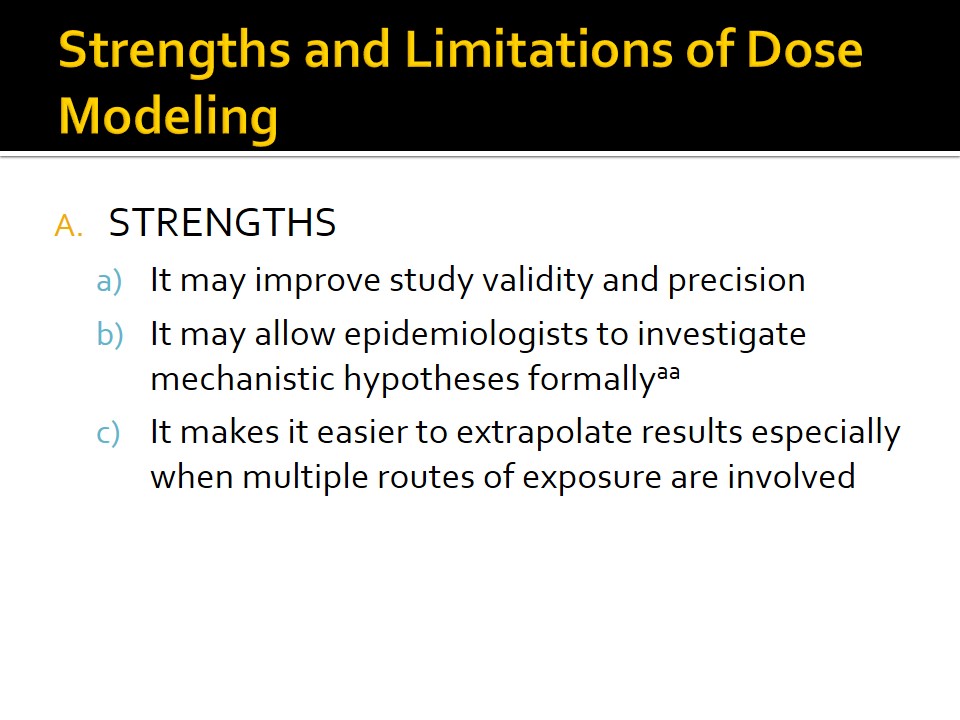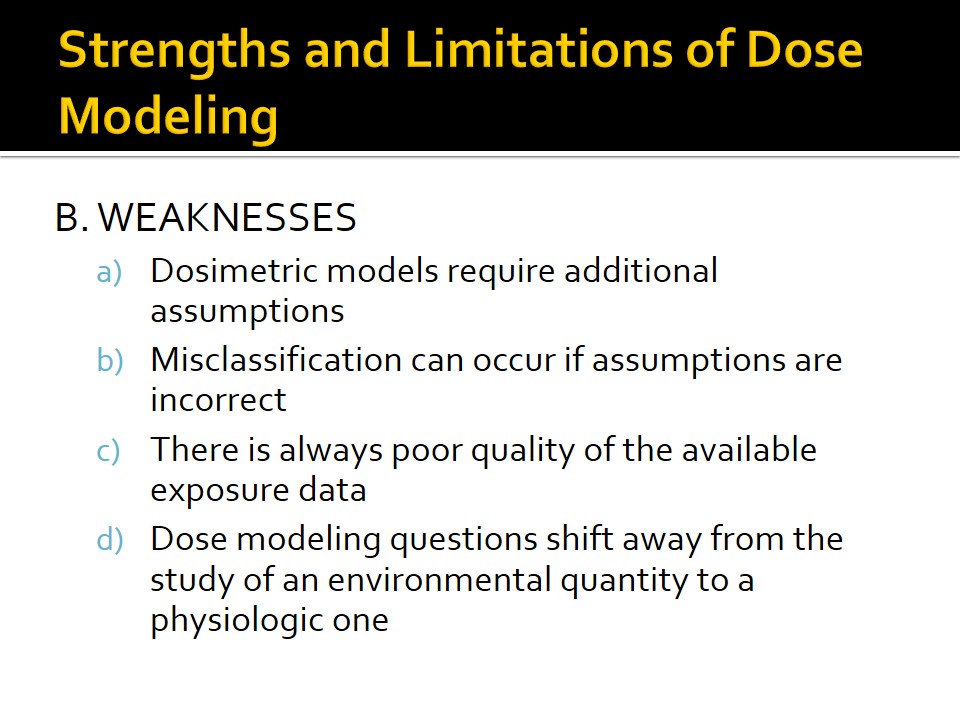Introduction
- Previous chapters covered concepts of exposure and dose.
- A framework to link environmental exposure, internal dose and physiologic responses was described.
- This chapter describes approaches to quantitative modeling of exposure and dose.
- The importance of characterizing the temporal dynamics of the exposure-risk relation will be shown.
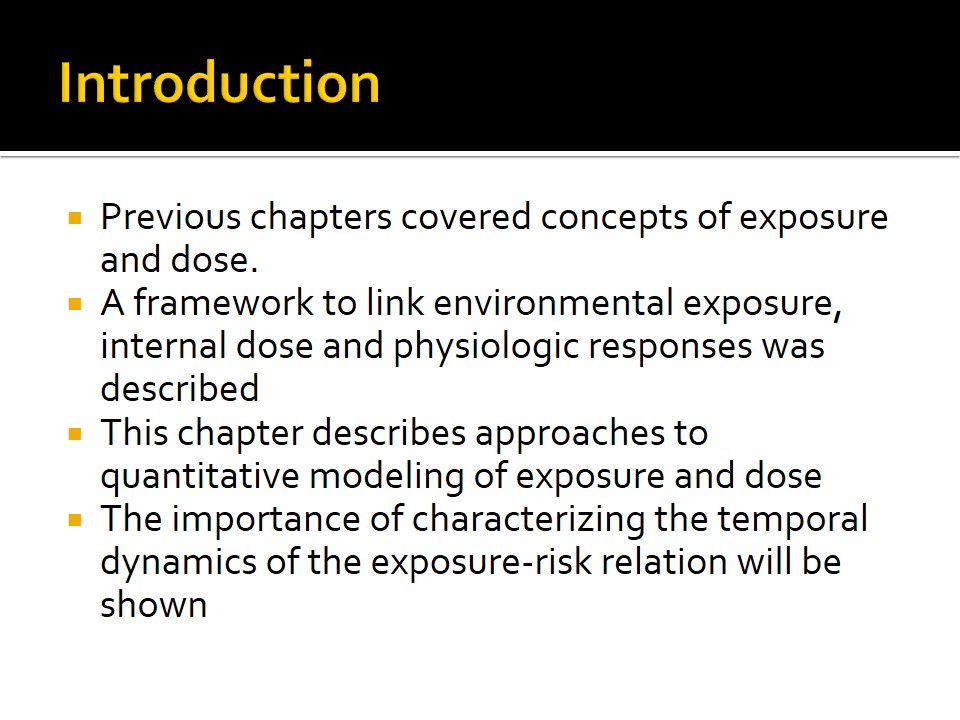
The Starting Point: The Exposure Profile
- Exposure is a complex, time-dependent quantity that must be summarized before its use in a model
- Exposure history to a hazardous agent by a worker can be summarized as:

where: xit =exposure level for worker I in time periods, t= 1,2,3…ni.
- Exposures must reach target organs and reach critical levels before injury occurs
- The profile of tissue concentration can be modeled as:

where: bit =tissue burden for worker i in time periods t= 1,2,3… ni
ni = No. of time periods of exposure of subject i prior to T.
- Burden of dose are not usually directly measurable.
- Hence, cumulative exposure is normally used.
- It is the time integral of exposure intensity.
- Duration of exposure is also a commonly used summary measure.
- If exposure intensities are constant, the duration of intensity will be proportional to dose.
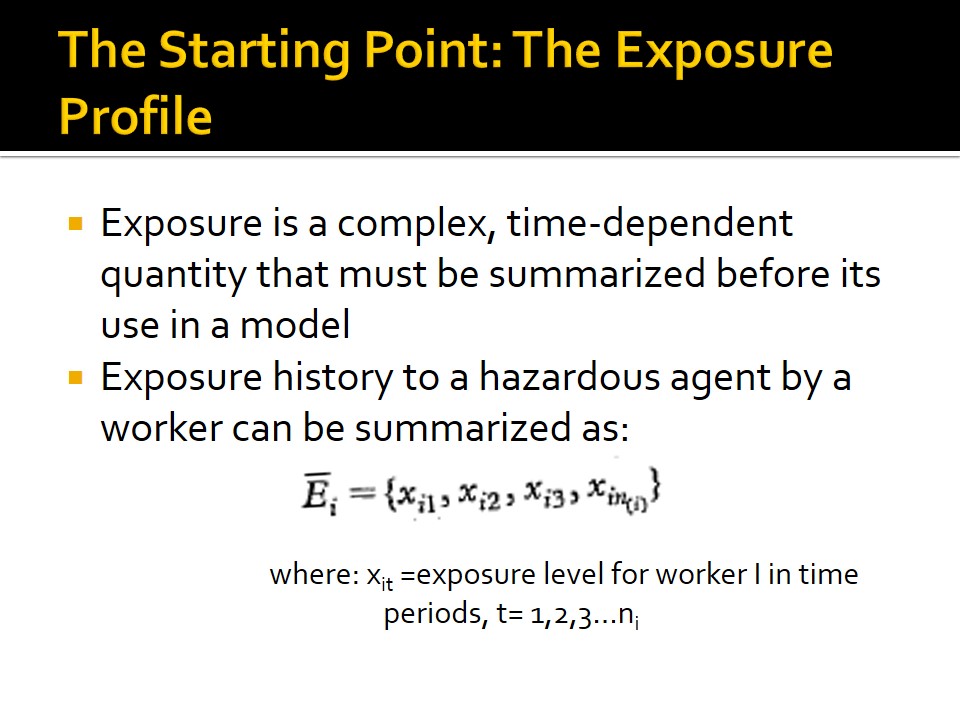
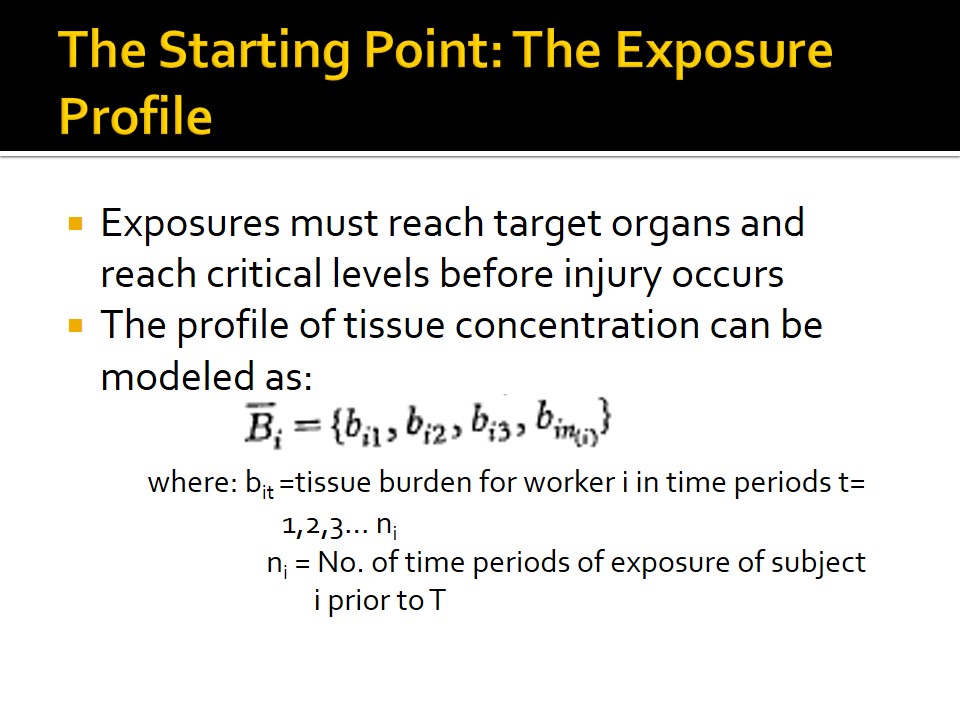
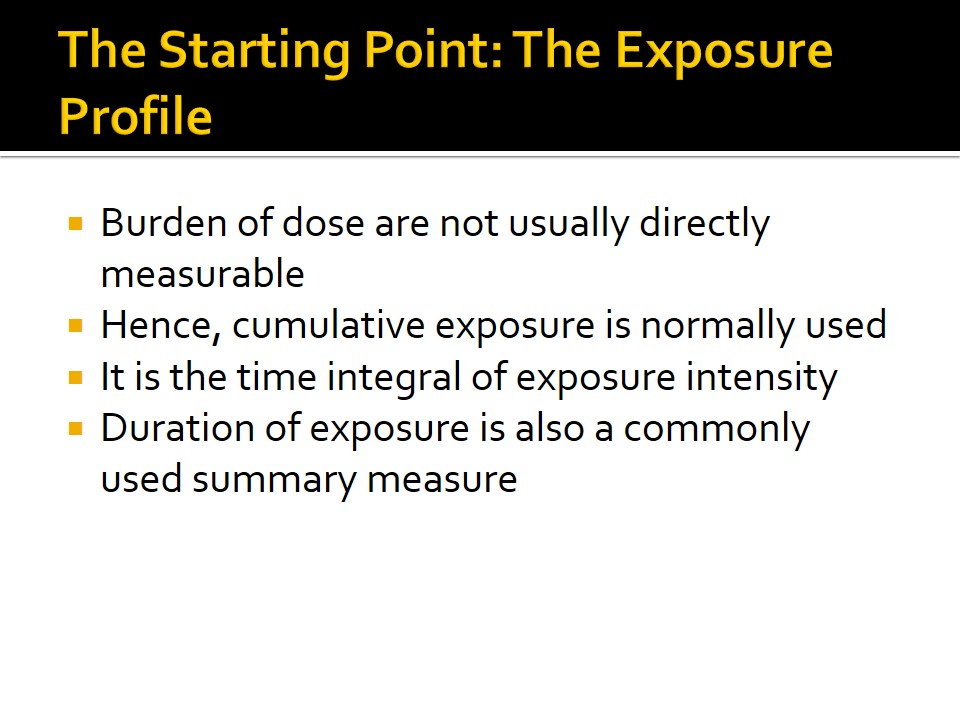
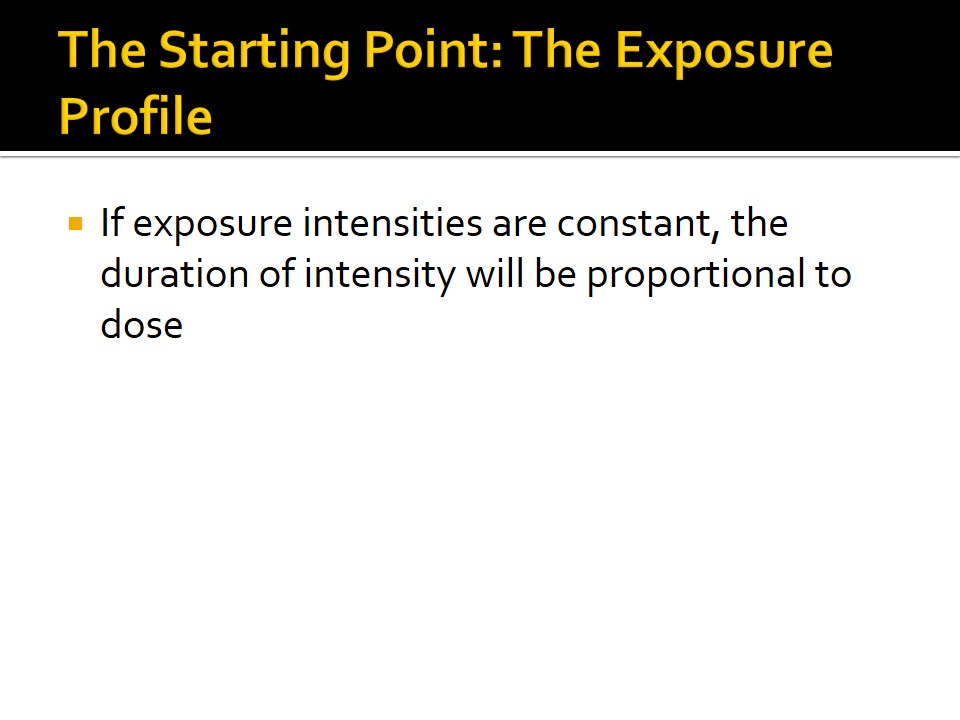
Exposure-Dose Relation
- Knowledge of ventilation rate can help compute the quantity of toxins inhaled.
- Use of ambient exposure data without accounting for dose can lead to wrong findings.
- Exposure can occur through lungs, skin or ingestion.
- It can be assumed that risk is proportional to dose.
- Hence, cumulative exposure is proportional to risk.
- However, risk may not be directly proportional to dose.
- This occurs when the degree of response to a given amount of dose varies over time.
- This calls for the use of a nonlinear model.
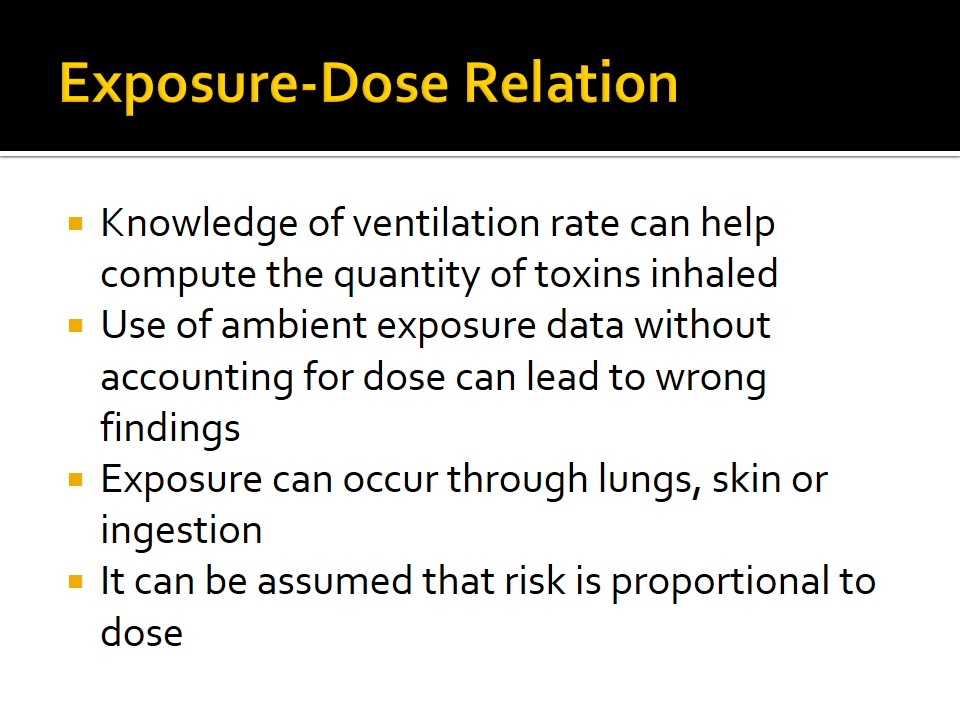
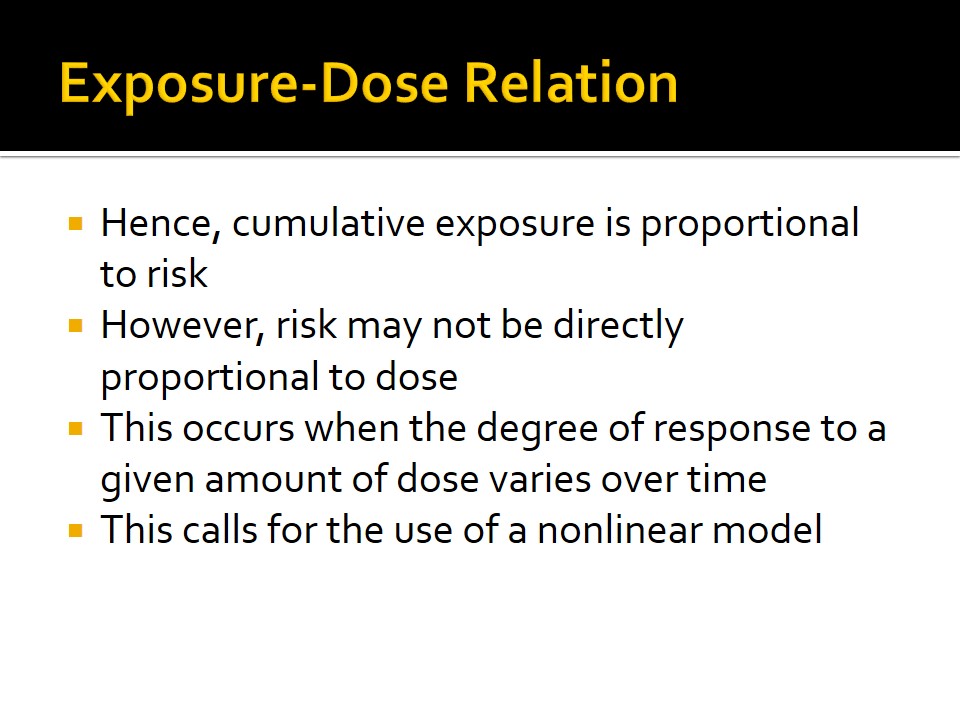
Dosimetric Model
- DM is used when risk is not proportional to dose.
- It is constructed based in explicit hypotheses about exposure-dose or dose-risk relations.
- DM can be used in the same way as summary measures of exposure.
- Steps in developing a DM:
- Development of model structure;
- Estimation of model parameters;
- Validation and testing of model;
- Model parameters are estimated from previous studies or directly from data.
- In the latter method, the data set must be fairly large and the number of unknown parameters small.
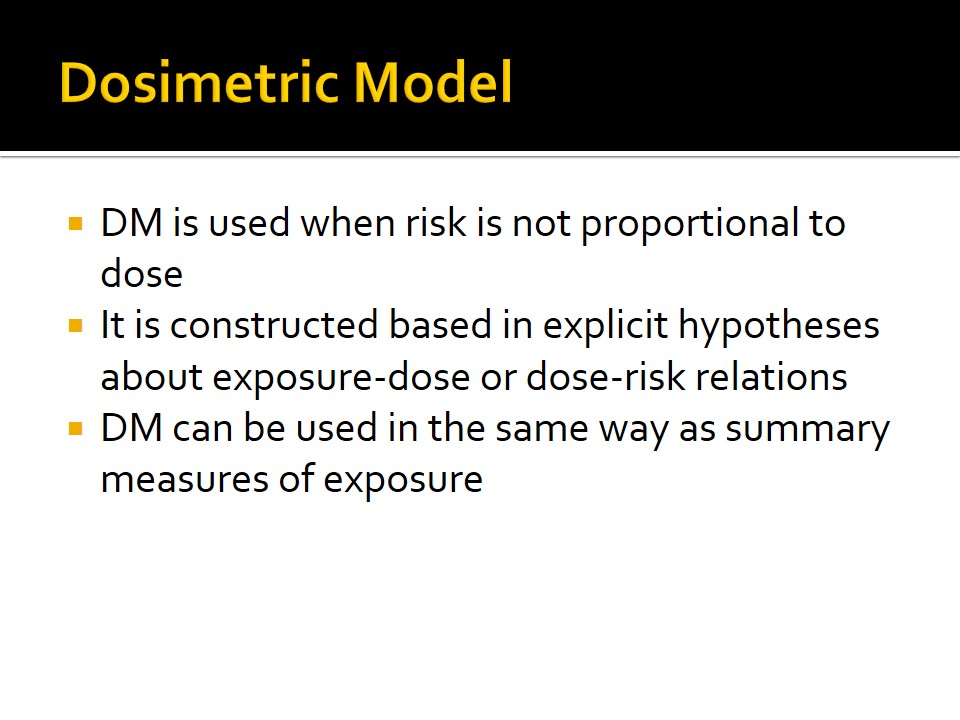
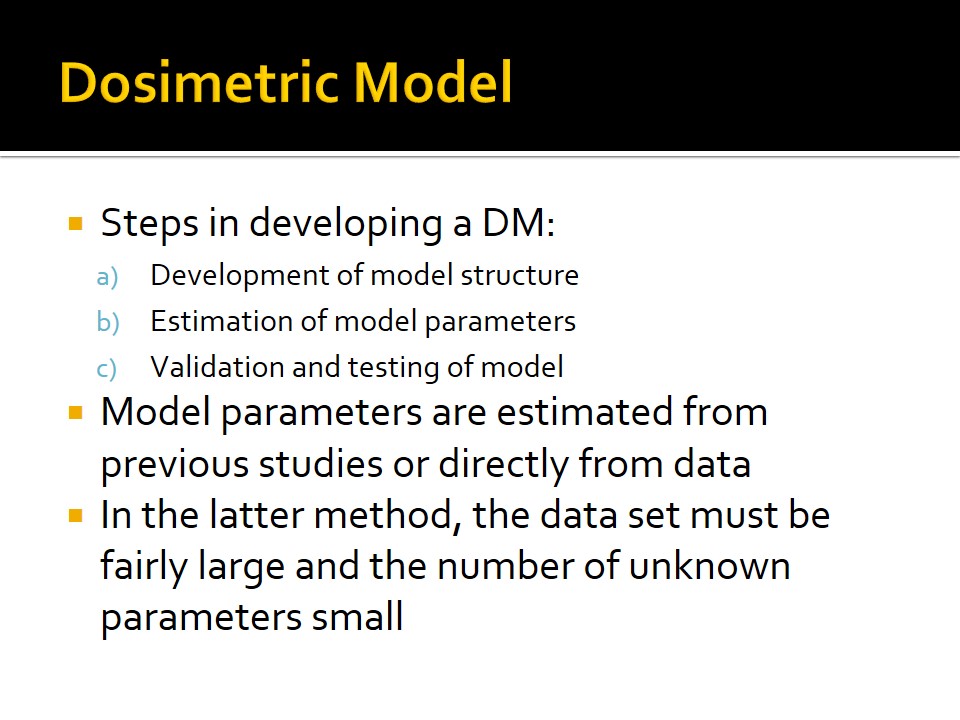
Incorporating Inter-Individual Variability into Dose Metrics
- DMs provide a formal , quantitative way to integrate data on individual risk modifiers into an epidemiologic analysis.
- DMs account for differences in ventilation rates to improve risk estimation.
- E.g. the effects of Ozone concentration on lung function are better explained by the product of ventilation rate and ozone concentration.
- Ozone’s airway effects are better predicted by more variables.*
- The human airway response to Ozone diminishes with age.
- Hence, a good DM must account for all of these variables.
- Exposure weighting is used.
*Studies show that Ozone’s airway effects are better predicted by complex functions of duration, Ozone concentration, and ventilation rates and not just a mere product of these functions.
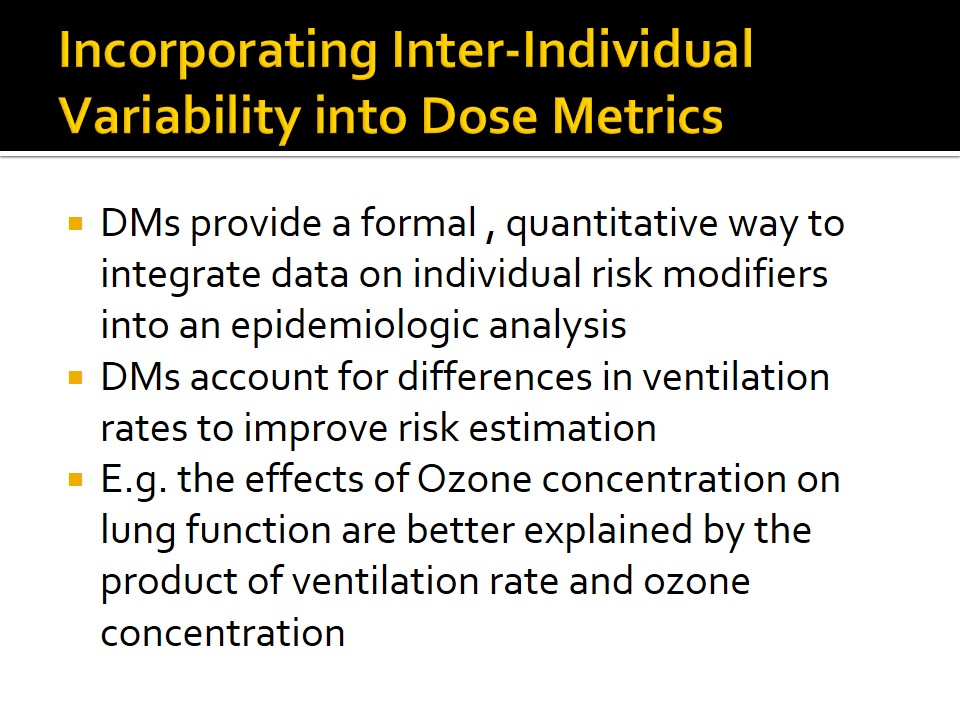
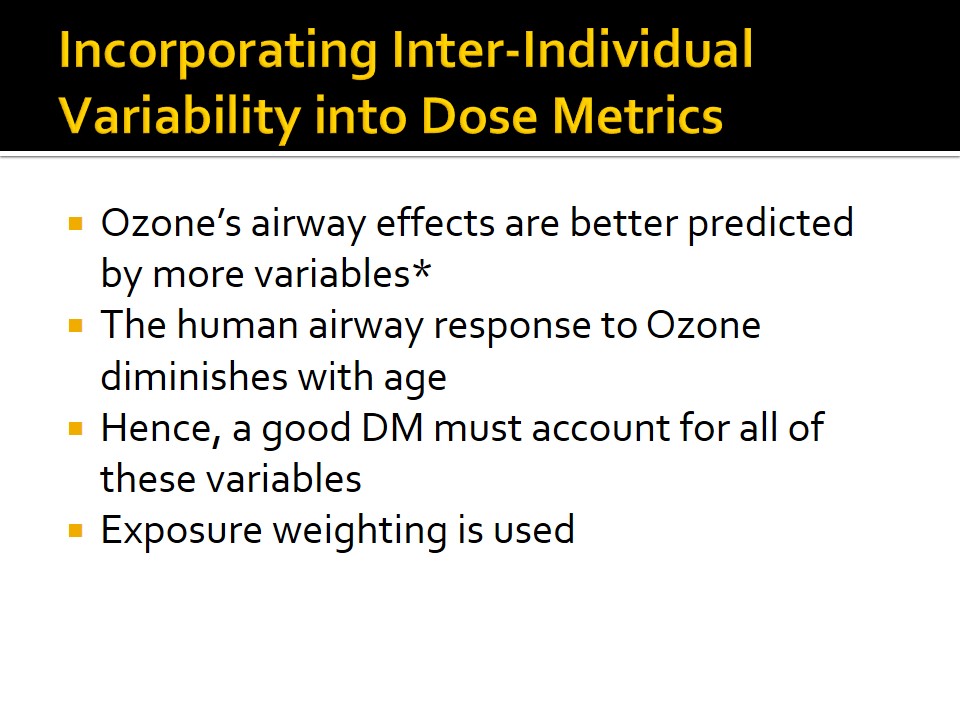
Exposure Weighting
- Even in the absence of strong biologic hypotheses, a summary measure of exposure is still required.
- Average values or cumulative measures can be used.
- The Seixas Exposure Index weights the different exposure indices.
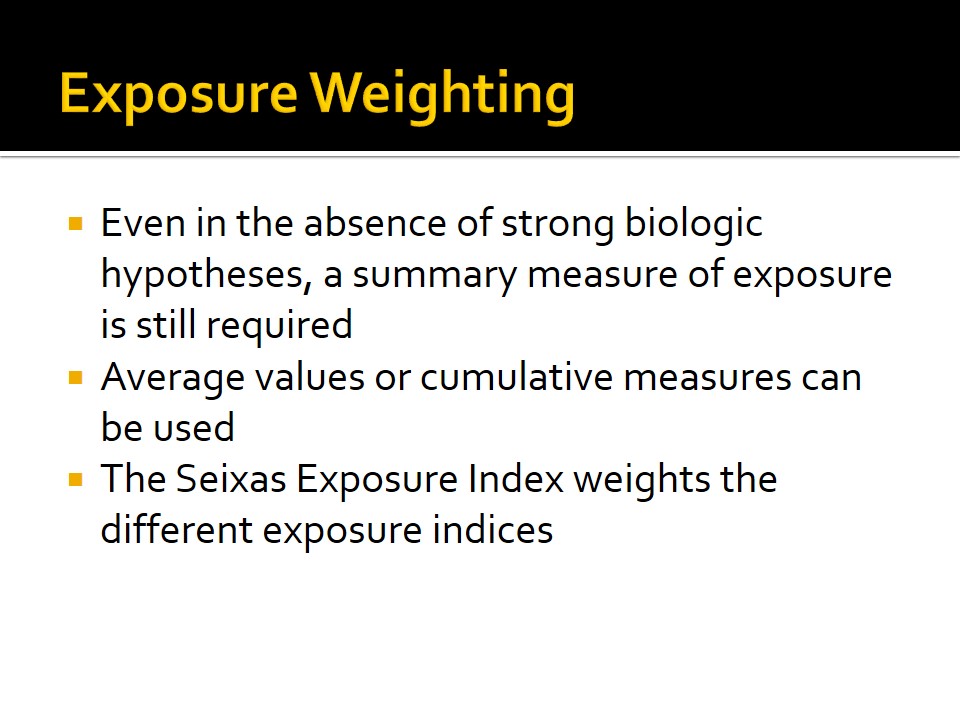
The Seixas Exposure Index
- Seixas has described a model to measure optimal weights of the form:

where:
- Ei =exposure index for the ith subject;
- Wij =indicator for the timing of exposure Xij;
- Xij =exposure intensity for subject i in time period j ;
- a and b are weighting parameters.
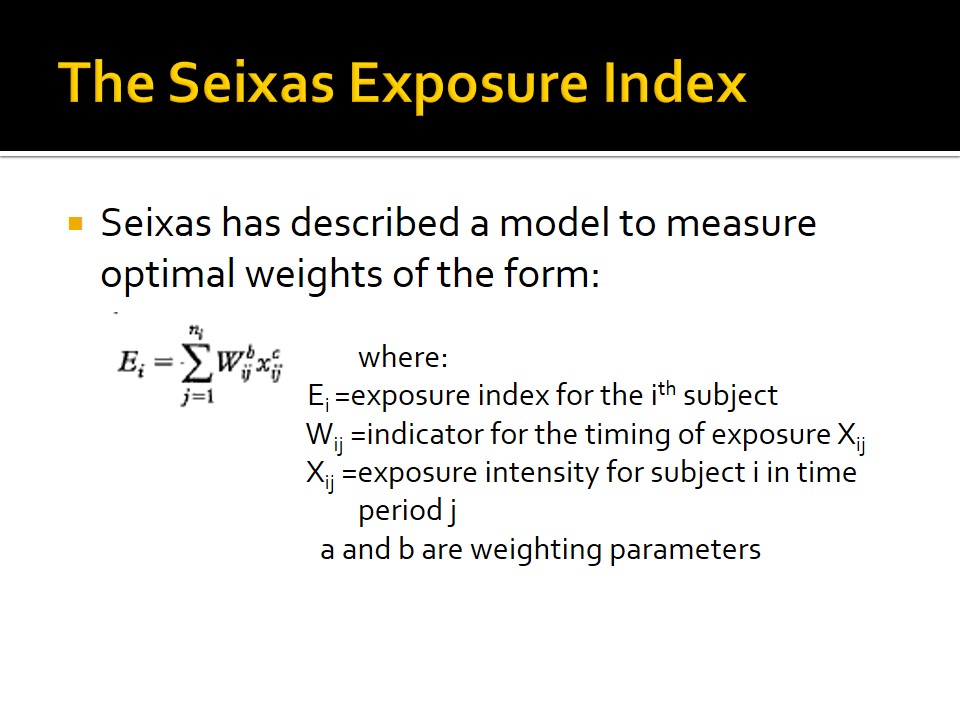
Induction Time Analyses
- This is another empirical approach to exposure weighting.
- ITA assumes that expected contribution of exposures will be constant during some time period.
- Both recent exposures and exposures that occurred in the more distant past are considered etiologically irrelevant.
- It can help to determine whether carcinogens operate late or early in the etiologic process.
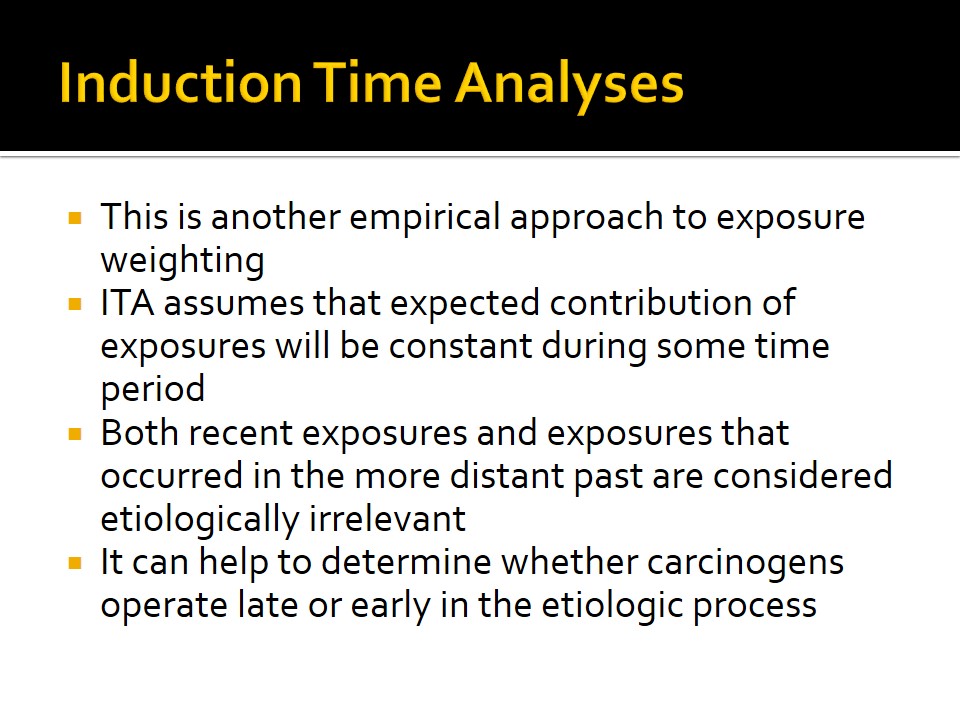
Multistage Cancer Modeling
- Is an improvement of ITA.**
- It is expected that all time periods should contribute some risk.
- MCM assumes that for cancer to ultimately occur, cells must pass through k distinct, heritable changes in a specific sequence.
- The simplest MCM model assumes that the background rate for a particular transition, j, is constant.
- In more complex models, the background rate may vary with several variables.***
- The underlying theory ni MCM is that cellular change j occurs with a background rate Rj that is independent of age.
**A limitation of ITA is that some time periods receive full weighting while others receive zero weighting
***In more complex models, the background rate may vary with factors such as age, condition of neighboring cells, or time since the cell experienced changes

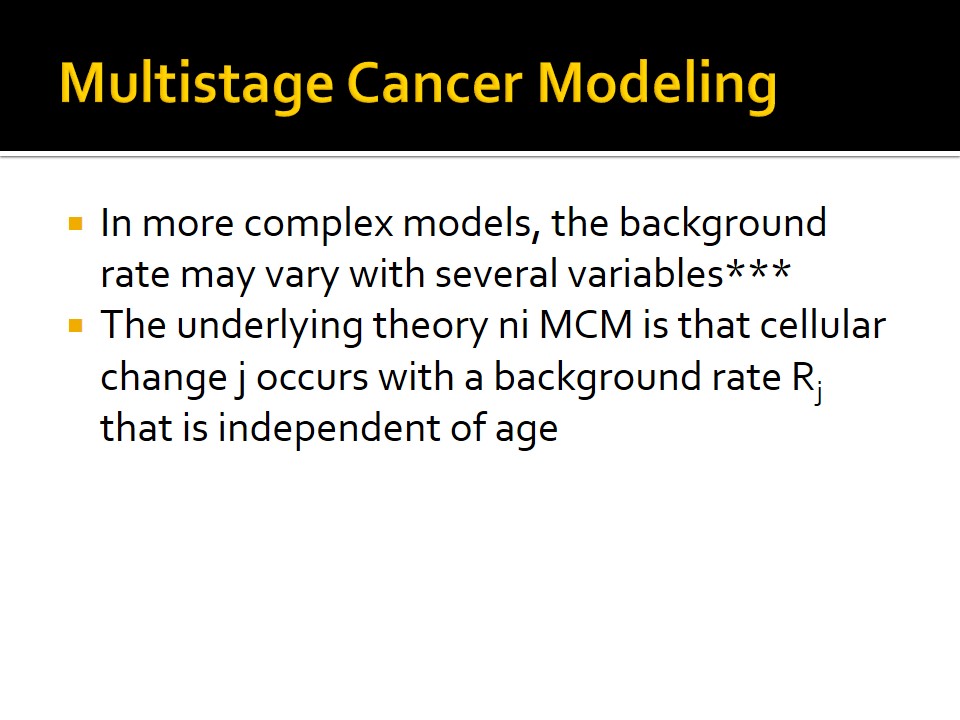
Choosing the Best Measure of Exposure or Dose
- Epidemiologic studies can be expensive and time consuming.
- Selecting just one measure of exposure/dose can be hard.
- In practice, many diverse measures are tested.
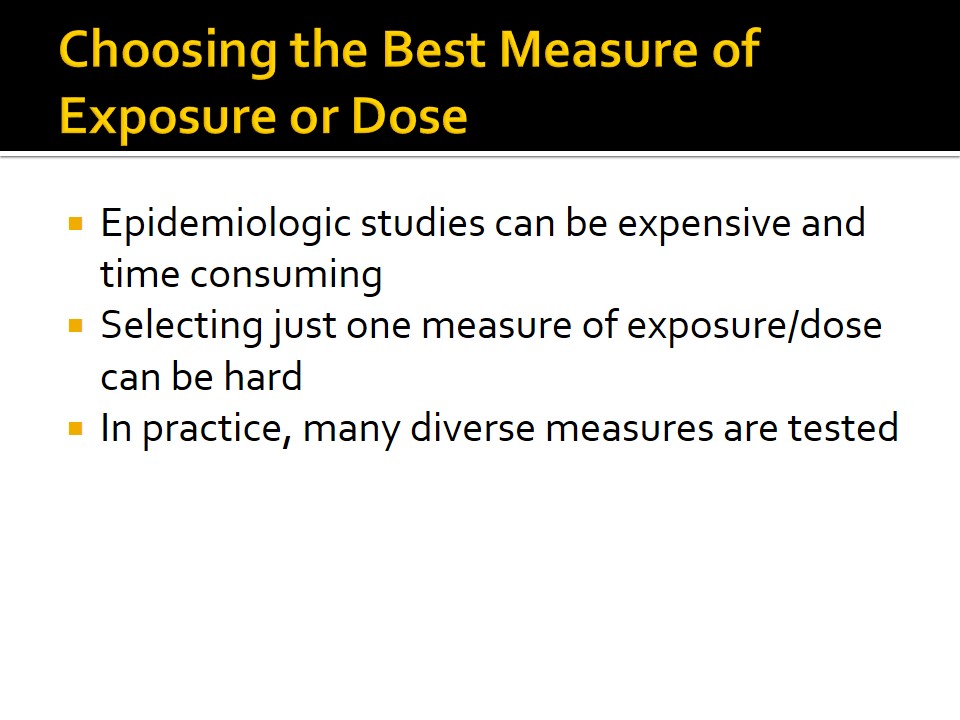
Criteria for Choosing the “Best” Measure of Exposure
- Generally, the better index will give a better statistical fit;
- Different indices have different scales and cannot be directly compared;
- Reasons for choosing a specific exposure index/dose metric can include:
- Ease of interpretation and comprehension;
- superiority in statistical performance;
- Dose metric may be preferable to exposure index if:
- There are several routes of exposure;
- If one wants to estimate the risk via all routes combined;
- If one wants to be able to use the results to make predictions on risks resulting from varied exposures;
- If one wants to consider interactions among different exposures.
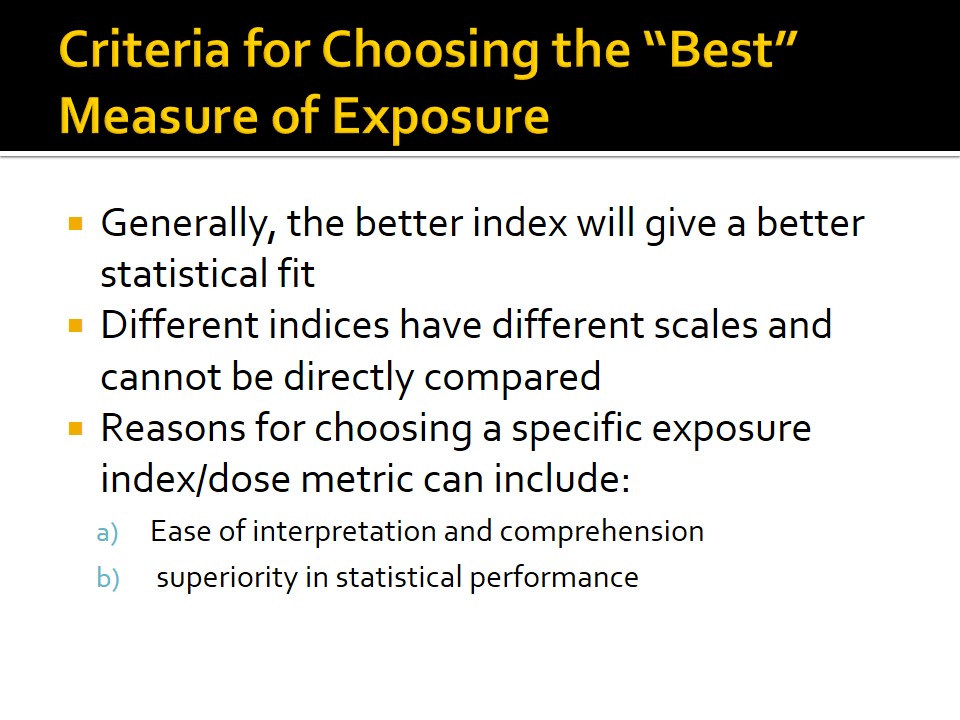
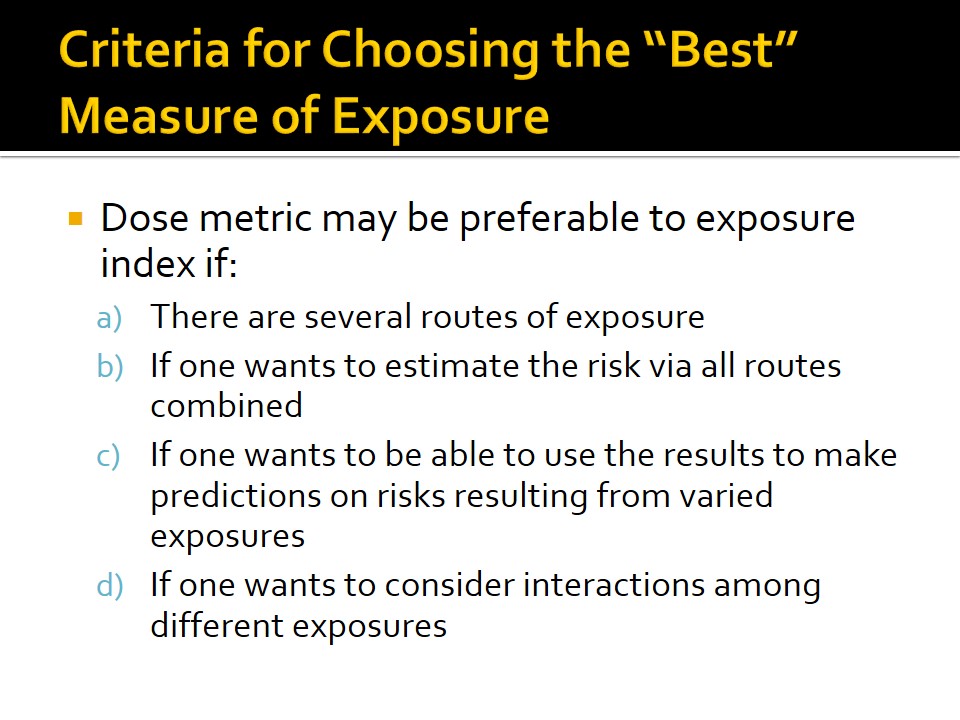
Strengths and Limitations of Dose Modeling
- Strengths:
- It may improve study validity and precision;
- It may allow epidemiologists to investigate mechanistic hypotheses formally; aa
- It makes it easier to extrapolate results especially when multiple routes of exposure are involved;
- Weaknesses:
- Dosimetric models require additional assumptions;
- Misclassification can occur if assumptions are incorrect;
- There is always poor quality of the available exposure data;
- Dose modeling questions shift away from the study of an environmental quantity to a physiologic one.
aa It may allow epidemiologists to investigate mechanistic hypotheses formally in a way that is not possible with simple measures of exposure.
